
Argyre Planitia is a plain located within the impact basin Argyre in the southern highlands of Mars. Its name comes from a map produced by Giovanni Schiaparelli in 1877; it refers to Argyre, a mythical island of silver in Greek mythology.

Galle is a crater on Mars. It is located on the eastern rim of the huge impact basin Argyre Planitia in Argyre quadrangle. It is named after the German astronomer Johann Gottfried Galle. Galle is often known as the "happy face crater" because pareidolia causes a curved mountain range in the southern part of the crater and two smaller mountain clusters further north to appear to be a smiley face. The formation was first photographed by Viking Orbiter 1.

Porter is a large-scale impact crater in the Thaumasia quadrangle on the planet Mars, situated in Aonia Terra at 50.8° south and 113.9º west. The impact caused a bowl 105 kilometres (65 mi) across. The name was chosen in 1973 by the International Astronomical Union in honour of the US astronomer and explorer, Russell W. Porter (1871-1949).

The Noachis quadrangle is one of a series of 30 quadrangle maps of Mars used by the United States Geological Survey (USGS) Astrogeology Research Program. The Noachis quadrangle is also referred to as MC-27.
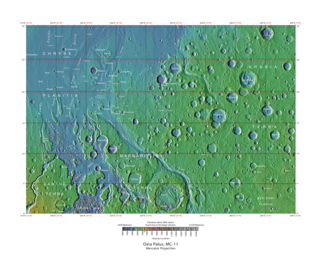
The Oxia Palus quadrangle is one of a series of 30 quadrangle maps of Mars used by the United States Geological Survey (USGS) Astrogeology Research Program. The Oxia Palus quadrangle is also referred to as MC-11.
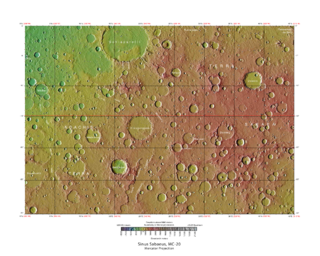
The Sinus Sabaeus quadrangle is one of a series of 30 quadrangle maps of Mars used by the United States Geological Survey (USGS) Astrogeology Research Program. It is also referred to as MC-20 . The Sinus Sabaeus quadrangle covers the area from 315° to 360° west longitude and 0° to 30° degrees south latitude on Mars. It contains Schiaparelli, a large, easily visible crater that sits close to the equator. The Sinus Sabaeus quadrangle contains parts of Noachis Terra and Terra Sabaea.

The Iapygia quadrangle is one of a series of 30 quadrangle maps of Mars used by the United States Geological Survey (USGS) Astrogeology Research Program. The Iapygia quadrangle is also referred to as MC-21. It was named after the heel of the boot of Italy. That name was given by the Greeks It is part of a region of Italy named Apulia. The name Iapygia was approved in 1958.
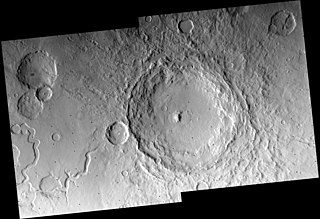
Cerulli is a crater in the Ismenius Lacus quadrangle on Mars with a diameter of 130 km. It lies in the northern hemisphere south of the very large crater Lyot. It is named after Vincenzo Cerulli, an Italian astronomer (1859–1927).

Trouvelot is a crater on Mars, located in the Oxia Palus quadrangle at 16.2° north latitude and 13.1° west longitude near the crustal dichotomy in the circum-Chryse region. It is roughly located along the dichotomy between Arabia Terra to the northeast and the southernmost of the circum-Chryse outflow channels to the southwest. Trouvelot crater measures approximately 148.77 kilometres (92.44 mi) in diameter and was named after Étienne Léopold Trouvelot, a French astronomer (1827–1895). The name was adopted by IAU's Working Group for Planetary System Nomenclature in 1973.

Eddie is a crater in the Elysium quadrangle of Mars. It is 89 km in diameter and was named after Lindsay Eddie, a South African astronomer (1845–1913).

Dawes Crater is located in the Sinus Sabaeus quadrangle of Mars, at 9.2 S and 38 E. It is about 191 km (119 mi) in diameter, and was named after William R. Dawes, a British astronomer (1799–1868) who was ahead of his time in believing that Mars only had a thin atmosphere. Dawes presumed that the atmosphere of Mars was thin because surface markings on the planet could easily be seen.

Bernard is a large crater in the Memnonia quadrangle of Mars, located at 23.4° south latitude and 154.2° west longitude. It is 128 km in diameter and was named after P. Bernard, a French atmospheric scientist. The floor of the crater contains large cracks, which may be due to erosion.
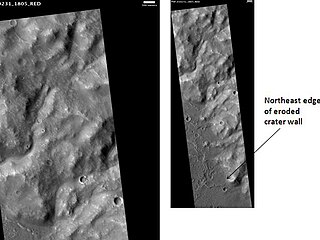
Escalante Crater is an impact crater in the Amenthes quadrangle of Mars. It is located at 0.2° N and 244.7° W. It is 79.3 km (49.3 mi) in diameter, and was named after Mexican astronomer Francisco Javier Escalante Plancarte.

Dilly is a crater in the Elysium quadrangle of Mars, located at 13.24° North and 202.9° West. It is only 1.3 km in diameter and was named after Dilly, a town in Mali.
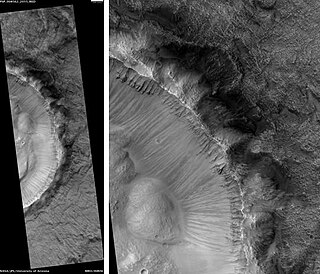
Grindavik is an impact crater in the Oxia Palus quadrangle of Mars, located at 25.39° North and 39.07° West. It is 12 km (7.5 mi) in diameter and was named after Grindavík, a town in Iceland. Impact craters generally have a rim with ejecta around them, in contrast volcanic craters usually do not have a rim or ejecta deposits. As craters get larger they usually have a central peak. The peak is caused by a rebound of the crater floor following the impact.

Arandas is a crater in the Mare Acidalium quadrangle of Mars, located 42.77° North and 15.17° West. It is 24.76 km (15.39 mi) in diameter and is named after the town of Arandas in Mexico.
Green is an impact crater in the Argyre quadrangle of Mars. It is named after Nathan E. Green, a British astronomer (1823-1899).

Danielson is an impact crater in the Oxia Palus quadrangle on Mars at 7.93° N and 7.11° W. and is 66.7 km in diameter, and is north of the Meridiani Planum, south of Arabia Terra. Its name was approved in 2009, and it was named after American engineer G. Edward Danielson.

Burton is an impact crater in the Memnonia quadrangle of Mars. It is 123.0 km in diameter and was named after British astronomer Charles E. Burton; the name was approved in 1973.
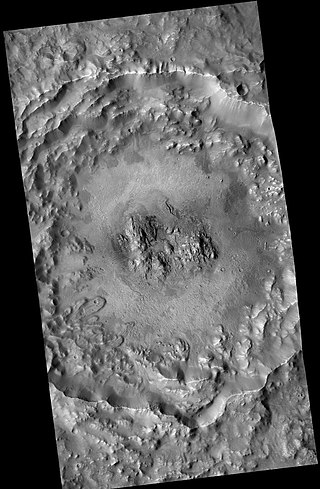
Auki is an impact crater in the Mare Tyrrhenum quadrangle of Mars, at 15.76 °S latitude and 263.13 °W longitude. It is 40.0 km in diameter and was named after Auki, a town in the Solomon Islands, in 2015 by the International Astronomical Union (IAU) Working Group for Planetary System Nomenclature (WGPSN).
























